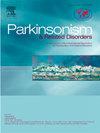杏仁核神经变性可区分脑先性和体先性帕金森病:核磁共振成像研究
IF 3.1
3区 医学
Q2 CLINICAL NEUROLOGY
引用次数: 0
摘要
本文章由计算机程序翻译,如有差异,请以英文原文为准。
Amygdala neurodegeneration differentiates brain-first and body-first Parkinson's disease: An MRI study
Background
Two distinct patterns of alpha-synuclein spread in Parkinson's disease were proposed with a body-first and a brain-first subtype. The body-first subtype originates in the periphery, while the brain-first subtype initiates in the central nervous system, notably affecting the amygdala.
Objectives
This retrospective cross-sectional study compared the integrity of the substantia nigra and amygdala between body-first and brain-first Parkinson's disease subtypes.
Methods
We analyzed data from 30 Parkinson's disease patients, classified into body-first (n = 21) and brain-first (n = 9) subtypes based on REM sleep behavior disorder history. Microstructural integrity was assessed using diffusion microstructure MRI.
Results
No significant differences were found in the substantia nigra between subtypes. However, amygdala degeneration was significantly pronounced in the “brain-first” compared to the “body-first” group reflected by increased free interstitial fluid (p = 0.02, Cohen's d = −1.22).
Conclusions
The degeneration of amygdala is distinctively pronounced in “brain-first” Parkinson's disease, supporting differential disease progression patterns between subtypes.
求助全文
通过发布文献求助,成功后即可免费获取论文全文。
去求助
来源期刊

Parkinsonism & related disorders
医学-临床神经学
CiteScore
6.20
自引率
4.90%
发文量
292
审稿时长
39 days
期刊介绍:
Parkinsonism & Related Disorders publishes the results of basic and clinical research contributing to the understanding, diagnosis and treatment of all neurodegenerative syndromes in which Parkinsonism, Essential Tremor or related movement disorders may be a feature. Regular features will include: Review Articles, Point of View articles, Full-length Articles, Short Communications, Case Reports and Letter to the Editor.
 求助内容:
求助内容: 应助结果提醒方式:
应助结果提醒方式:


